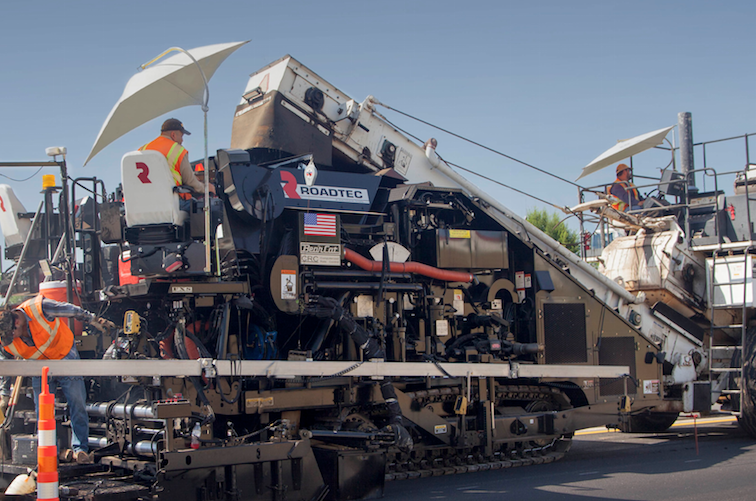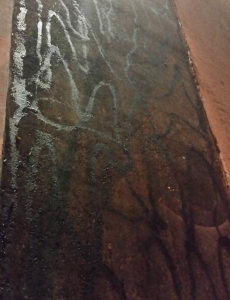How to Sell, Construct Thin Asphalt Overlays
BY Sandy Lender

Problem: State and local agencies have been dealing with limited budgets for such a long time that some pavements in their jurisdictions have passed the point where a pothole patching or crack filling crew will adequately solve the distresses.
Solution: Asphalt professionals can help agencies decide when a thin asphalt overlay is the right tool from the pavement maintenance arsenal to extend a pavement’s service life.
Steps: Start by defining the distress of the pavement in question, and the capabilities of the thin overlay type. Don Watson at the National Center for Asphalt Technology (NCAT) in Auburn, Alabama, shared with the Transportation Research Board’s (TRB) “Thin Asphalt Concrete Overlays” webinar audience June 20 that “What you put it on matters.” The thin asphalt concrete overlay, according to NCAT, has a number of advantages, including:
- providing a long service life (when placed over structurally sound pavements);
- providing a good riding surface;
- reducing noise (up to 3 decibels or more of noise reduction when fine-graded mixes are used);
- maintaining grade and slope geometry;
- providing ease of maintenance; and
- recycling (thin asphalt overlays can be recycled in the future).
Notice the first advantage of a thin overlay is to extend a pavement’s service life, but this depends on the pavement. Michael Heitzman of NCAT also spoke during the webinar and explained to the audience that agencies must place importance on the current pavement condition when selecting the mix type they wish to use for a thin overlay. That’s right: agencies have options within the thin overlay concept (See Sidebar A). Heitzman stressed in his presentation that those mix types are not interchangeable, and not every pavement is a candidate for thin overlay.
“Simply placing a thin overlay on a pavement may not be the right answer,” Heitzman said. “For a good pavement preservation program, distresses and pavement conditions must be considered in the selection process.”
Watson showed pictures of roadways with alligator cracking and ruts greater than 2 inches in depth. Such structural distresses cannot be cured with a thin lift. “Pavements that are failing, or have already failed, cannot be successfully treated with a thin overlay alone. If cracks are already at a high severity level, or if you have severe rutting, a thin overlay will not solve your problem.”
Your estimator may need to suggest the county perform work prior to the overlay. Heitzman said, “Pre-overlay work affects the cost, but also improves the end result and life of the project.”
In other words, if the crew needs to perform minor crack filling prior to the thin overlay, that added cost may pay for itself several times over in added years of pavement service life. If the crew needs to perform milling prior to the thin overlay, again, that added cost may pay for itself several times over in multiple added years of pavement service life.
Keep in mind, a thin overlay is not necessarily supposed to add structural capacity to the pavement. Heitzman said, “To get additional structural capacity with a thin lift, you’ve got to get it on before there’s any fatigue damage” in the underlying pavement.

This tack has been poured from a melter by hand and is streaked across a small section of pavement in a haphazard manner. Don’t use this method of tacking and expect a good bond between a thin overlay and the existing surface. Photo courtesy Sandy Lender.qThis tack has been poured from a melter by hand and is streaked across a small section of pavement in a haphazard manner. Don’t use this method of tacking and expect a good bond between a thin overlay and the existing surface. Photo courtesy Sandy Lender.
Keep in mind, the thin asphalt concrete overlay is loosely defined as being anywhere from three quarters of an inch to 2 inches compacted, depending on the agency you ask. Watson shared that NCAT decided, for the purposes of surveying agencies, its researchers would define the thin asphalt concrete overlay as no more than 1.5 inches thick. He told the audience, “Generally, the thicker the overlay, the longer it will last.” Again, the condition of the base matters. Watson said, “Put it on a good base pavement and you can get an equal life out of” either the thin or thicker lift.
Once you’ve decided the thin overlay is the right preservation tool, construct it with best practices for best, long-life results. As Watson shared with the audience, the thin overlay can add five to 12 years to a pavement’s service life. Of course NCAT looked into the reasons behind that wide variability. Some agencies construct thin overlays as stop-gap measures, intending the small amount of material to be a short-term, temporary fix to buy some time—such as five years—to get them to a period in time when they could afford the larger, more budget-taxing, pavement rehabilitation projects. Other agencies reported weather conditions, and construction and materials quality on low-volume/rural roadways as contributing factors to the lower number of years added to service life. Such variables can be eradicated when asphalt professionals give best practices priority for each and every thin overlay.
Both Watson and Heitzman stressed the added importance of time and temperature when working with a thin overlay versus typical lift thicknesses. “There’s no shortcut to making sure the mix comes out hot, gets placed hot, and the roller gets on it,” Heitzman said.
Watson suggested the crew may need a second roller in the breakdown position for the logical reason that the paver can travel faster when placing a thin lift of 1 inch than it can when placing a thicker lift of 2 or 2.5 inches. “Your paver’s going faster so you want to make sure your paver’s not out-running the rollers,” he warned.
The crew will want to manage density differently than they do when on a new construction project. For example, Heitzman said, “Our density gauges won’t apply on a 1-inch lift.” Instead, build a rolling pattern based on number of passes.
Another best practice to employ is the proper application of tack. Spraying tack between the existing pavement and the thin overlay isn’t optional—it’s a necessity. Keep an eye on the equipment that might travel on the tacked surface, keeping that traffic to a minimum. The quality of the tack will be diminished by dirty truck tires picking it up and carrying it away. You don’t want to skimp on this important step. Watson said, “Get a good tack spray so you don’t have delamination later.”
Also look to the mix design. Watson emphasized getting enough asphalt in the mix. “That applies to any overlay or mix, but it’s critical for thin overlays.”
—
Types of Thin Overlays
4.75 mm Superpave
9.5 mm Superpave
12.5 mm Superpave
4.75 mm stone matrix asphalt (SMA)
9.5 mm SMA
12.5 mm SMA
Ultra-thin bonded wearing course (UTBWC)
Open-graded friction course (OGFC)

